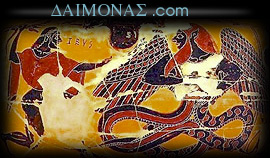A BRIEF OUTLINE ON THE TRIDENT AND BATTLE-AXE
The European battle-axe appears in the metal working centres of the Caucus at around 2500 BC:
"The most striking new form [of weapon] was the metal battle-axe: not the shallow balanced axe-adze or axe-hammer... but a more effective , deep-bladed type with a shaft hole at the end.... It was these innovations, together with Bohemian tin, that were to give the central German metalsmiths their scope..." p.261, " Andrew Sherratt, "The Emergence of Elites: Earlier Bronze Age Europe, 2500-1300 BC", Chapter 7, Prehistoric Europe, edited by Barry Cunliffe Isbn: 0192880632
This axe rapidly spread throughout Europe. "In Europe the Battle-Axe folk moved northwards along the Volga and westwards across the open plains of Poland and Germany. By 1600 B.C. they had reached Denmark and the Rhine valley..." p.210 Ancient Iraq Georges Roux ISBN: 0140208283
In the aftermath of the collapse of the Bronze Age civilizations, which according to the Greeks was due to the invasions of the Herakleide, the children of Herakles (Dorians) who came from the north, the TRIDENT becomes the motif of choice to represent god. Trident-wielding gods brandishing European Battle-Axes appear in reliefs during the 10th-9th centuries BC in Anatolia and along the Levantine coast, and replace previous representations of "storm gods".
Hesiod, over a century later ,ascribes the thunder weapon of Dios ("Zevs") to the 3 manifestations of lightning: the flash, the bolt, the thunder. This is the trident. The earliest representation of both the Battle-Axe and the trident occurs in the north of Europe, in Scandinavia. There, on bronze-age petroglyphs, which date from the 17th-16th centuries BC (when the Mycenaeans ruled Greece) are depicted Battle-Axe wielding soldiers with beak-prowed boats. In the sky is represented a disc, the cosmos, and is surrounded by 7 tridents; that is, the cosmos is represented as being ruled by a divinity whose symbol is the trident. It is the bearer of the trident who controls the seven wandering bodies: the sun, moon, and 5 planets visible to the unaided eye.
|

Above, bronze Age Swedish petroglyph (c.1600 BC) depicting warriors bearing the European Battle-Axe. In the sky is a disc surrounded by 7 tridents.
Image source, p.271, Norse Mythology. A guide to the gods, heroes, rituals, and beliefs, by John Lindow. ISBN: 0195153820
|
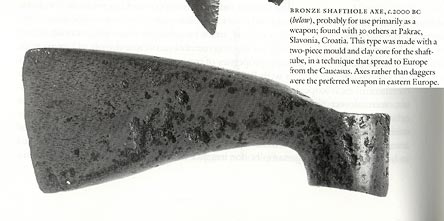
Above: a European battle-axe, c.2000 BC found in Croatia.
Image Source p.262, Prehistoric Europe, edited by Barry Cunliffe ISBN: 0192880632
|

Above: the trident wielding gods that appeared in the aftermath of the collapse of Bronze Age civilizations all wield the European Battle-Axe. The above example is neo-Hittite and dates to the 9th century BC.
The neo-Hittites replace the chief god of the Hittites, Hattusas & chief god of the Hurrians, Tessub (Teshub), with TARHUNDA-of-the-sky.
Image Source: plate .550, The Art of the Ancient Near East
by Pierre Amiet
ISBN: 0810906384
|
It may be coincidence that TARHUNDA sounds like the Germanic Thunder/ Donar/ Thonar/Thunaer...:
- *Dyeøus Ph2ter is believed to have been the original name of god of the daylit sky and the chief god of the Indo-European pantheon. He survives in Greek Zeus [ZEVS](also Dias [Dios]),
- A thunder god, possibly associated with the oak, and in some traditions syncretized with Dyeus. An onomatopoeic root *tar is continued in Gaulish Taranis and Hittite Tarhunt. A word for "thunder" itself was *(s)tene-, continued in Germanic *<THORN>unraz (thunder personified), and became Thor.
- [From the wikipedia]
http://en.wikipedia.org/wiki/Proto-Indo-European_religion
|
The representation of this god bearing a trident and European Battle-Axe demonstrate his European origins.
It should be noted that when the neo-Assyrians first begin to depict the vanquishing of Marduk, they depict their god brandishing a European Battle-Axe (refer image below).
A cautionary consideration:
"The Weather-god of the Luwians and the Neo-Hittite kingdoms was Tarhunta or Tarhuis 'the Conqueror'; and the same name in the form of Tarhunna, was most probably in use among the Hittites themselves - for tarh- 'to conquer' is a Hittite verb - though it cannot be located in any particular area. This name (or epithet) is the origin of the Etruscan Tarchon." p.138 O. R. Gurney The Hittites. ISBN: 0140202595
|
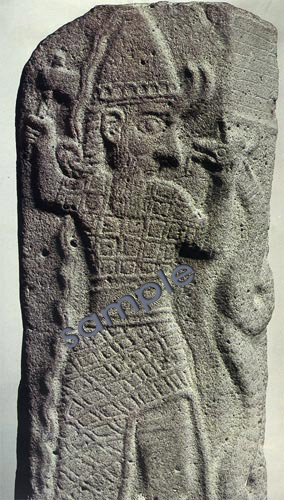
This stele, dedicated by an Assyrian king depicts a horned god smiting the horned serpent Marduk. This god wields a European battle-axe.
Image source: illus. 102 The Art of the Ancient Near East
by Pierre Amiet
|

"Ninurta attacking Anzu", from Nimrud. (Layard, Monuments of Nineveh, ii, plate 5)
Incredibly, the Assyrian Ninurta is brandishing a double Trident, which replaces the European battle-axe. Here are represented the three manifestations of Lightning, and symbol of the World Tree, none of which are Semitic.
(This image is scanned from the cover of Dalley's Myths from Mesopotamia.)
|
Entering the Greek world, the trident wielding god is conflated with the god who fought the monster Typhon, the volcano at Thera which erupted at c.1623 BC. Wielding his "thunder weapon", the trident (the volcanic lightning associated with the eruption) , ZEVS fights and eventually defeats TYFON, the volcano. This tale which conflated Northern European and Aegean motifs travelled all the way to India where it is recounted as the battle between Indra and Vritra.
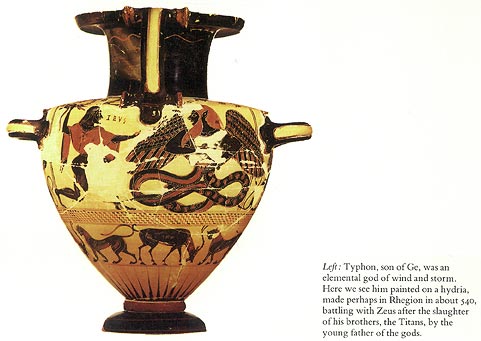
ZEVS armed with the double-trident attacking TYFON. [on Greek pronunciation]
Image source p. 92 The Emergence of Greece Alan Johnston. Isbn: 0729000435
Below, detail:
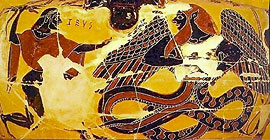
|
The logo of this site shows ZEVS brandishing the double-trident as he fights the volcano TYFON.
The Double-trident is symbolic of the Indo-European holy-number 3. It consists of three "prongs", but is also composed of 3 parts: the Upper-trident, the Lower-trident, and the Stem. As such it symbolises another motif of the Indo-Europeans: the world tree. The numerical significance of the double-trident is: 3 (branches) x 3 (roots) = 9, the holy number of the Indo-Europeans. Its roots+branches+trunk=3 which when multiplied by 9 = 27 (the number of days in the lunar month in which the moon is visible). And, if we adhere to the number system that recurs throughout Homer, we can conclude: 3x3x3=27 days in the cycle of the moon, but, on the 28th day there is no moon ("new moon"). This is the Indo-European division of the lunar month into 3 phases, not the Semitic 4 x 7 = 28. The trident is also a symbol of fertility, as was Thor's 3-ended "hammer".
The trident, symbol of the bull-horned, master of the heavens, has since been inverted by the Christians to become the symbol of a monster, the symbol of the Devil, of unspeakable evil. The syncretist tolerance which characterised Greek religion was replaced by the ideals of the Judaic faith:
"You must destroy all the peoples the LORD your God gives over to you. Do not look on them with pity and do not serve their gods..." Deuteronomy 7.16 Jewish "Old Testament";
"Break down their alters, smash their sacred stones and cut down their Asherah poles." Exodus 34.13 Jewish "Old Testament"
OR AS THE EQUIVALENT PASSAGE IN THE SEPTUAGINT READS:
"Ye shall destroy their alters, and break in pieces their pillars, and ye shall cut down their groves, and the graven images of their gods ye shall burn with fire." Exodus 34.13 Septuagint "Old Testament"
(This can refer to non other than the Indo-European Philistines, known to be Mycenaeans, worshipping the pillar and the World-Tree. Note for instance the Lion gate of Mycenae, where two lions proudly guard the world-pillar as well as Mycenaean sacred-groves depicted on Mycenaean signet rings.)
Good has come to be replaced by evil and that which is evil came to be considered good.
It should also be pointed out that the trident which appears in Scandinavia is eventually adopted by the Jews and then modified to form the "menorah", to thus make it represent their holy number, "7":

Above Image Source: p.34. The Romans, Lyttelton and Foreman. ISBN:0856134732. Detail from the Triumphal Arch of emperor Titus in Rome, depicting the spoils of war after the destruction of Jerusalem in AD 70.
|
|
Beliefs are only ever surrendered grudgingly. We are inherently stubborn and resistive to change. The trident depicted in the Swedish petroglyph persisted for over two and a half thousand years and can be seen in the form of the 3-pointed flag of the Varangian guard. Additionally, these warriors, like their ancestors of 2 500 years earlier, continue to wield the battle-axe.
The Varangian guard, the elite guard of the Byzantine Emperor, comprised of Scandinavian warriors. Initially these were the Rus. Eventually they were replaced by Swedes. After the Norman conquest of England the Varangian guard came to be drawn from Anglo-Saxons who left England ( p.34 The Viking World, James Graham-Campbell ISBN: 0906459044).
Image Source: p.124. The Penguin Historical Atlas of the Vikings, John Haywood. ISBN: 0140513280. Illustration from a manuscript by Byzantine historian John Scylitzes.
|
[... I'll end this essay here ...]
|
